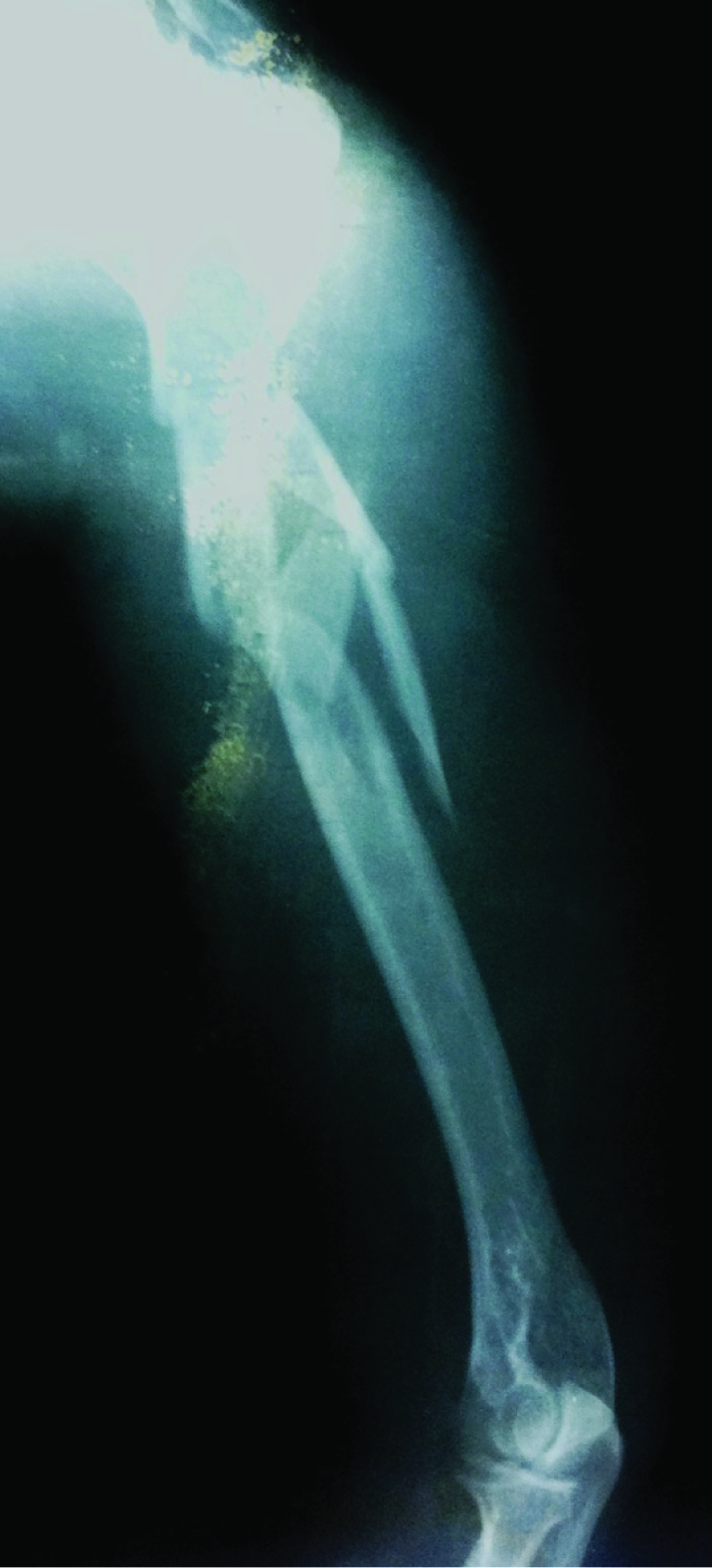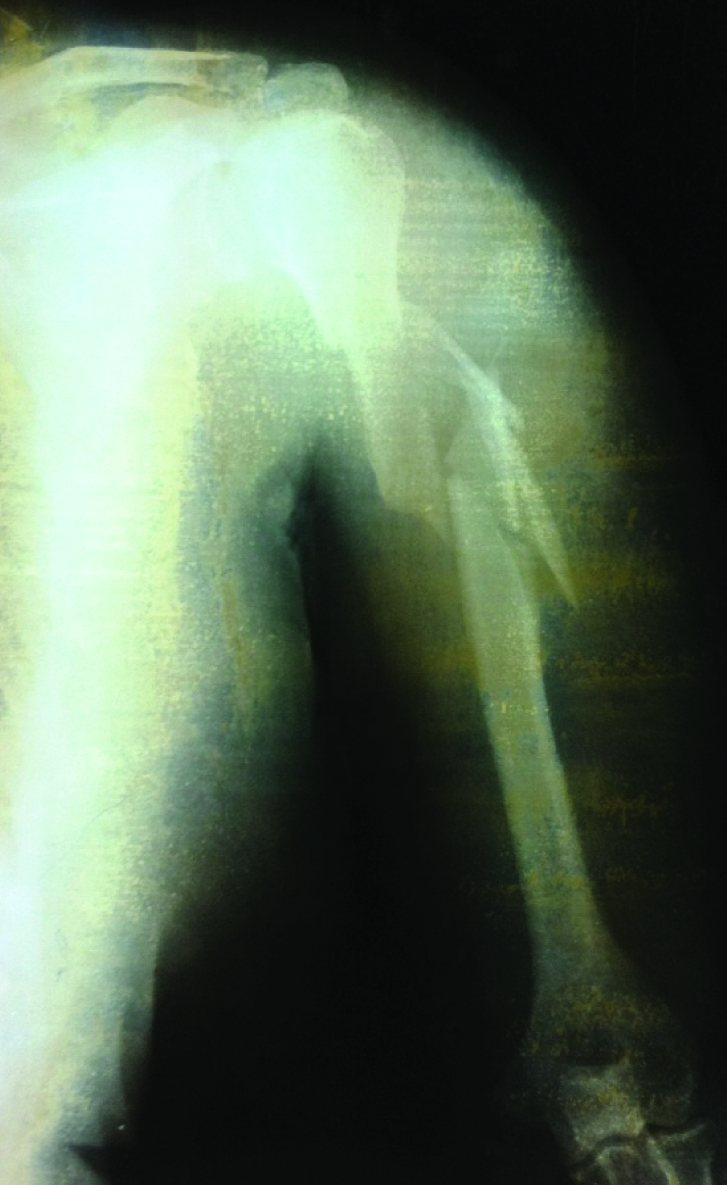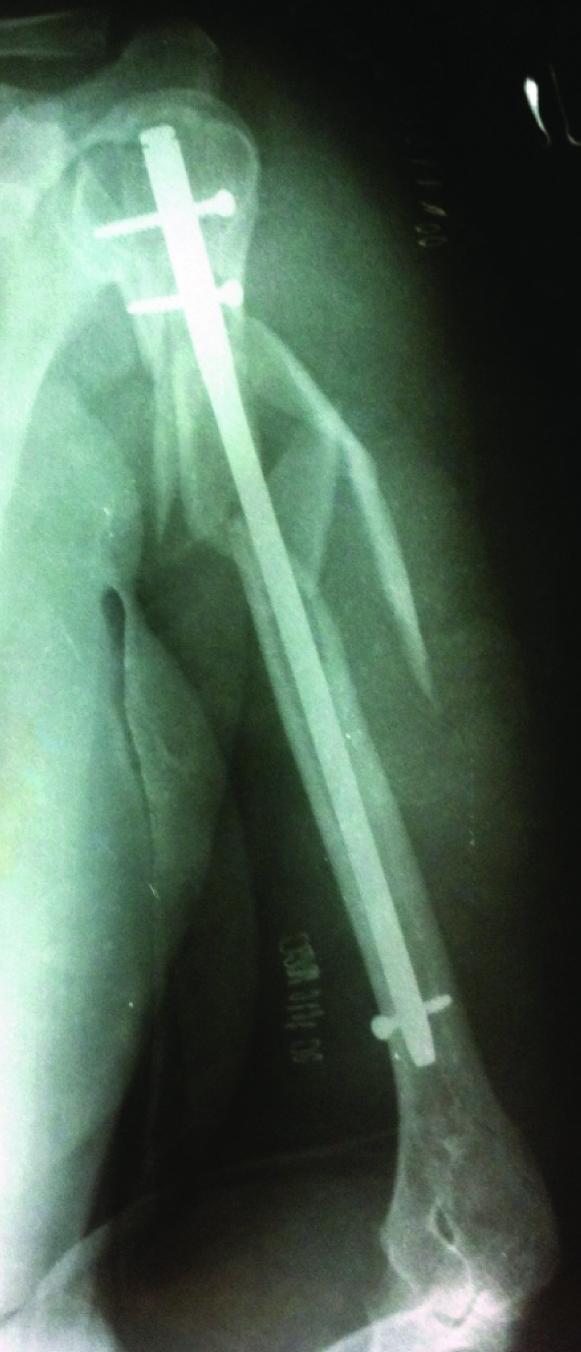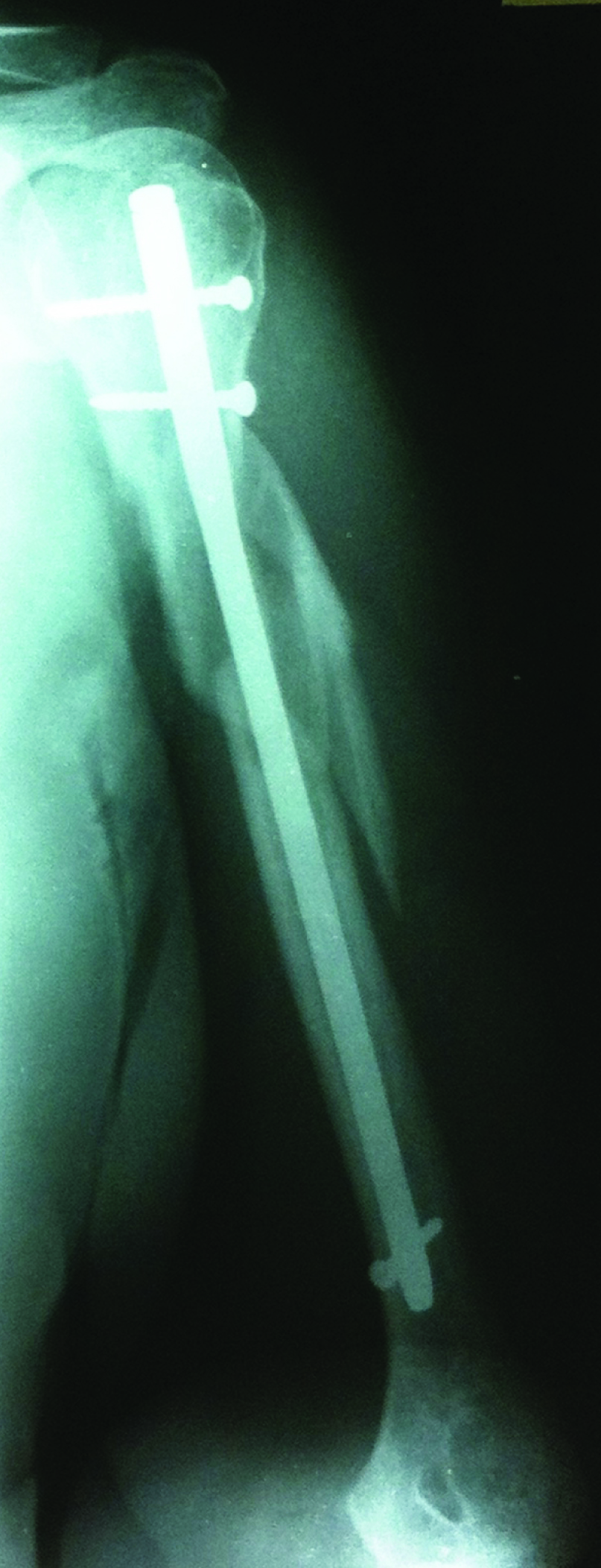The fractures of the shaft humerus are fairly common accounting for 1-3% of all fractures and 20% of all humerus fractures [1,2]. Upto 90% of humeral shaft fractures are reported to be treated conservatively with functional bracing. Conservative management is the most common modality for treatment of humeral shaft fractures. Operative treatment includes dynamic compression plate osteosynthesis, intramedullary nailing or external fixation, depending on the geometry of the fracture and other concomitant injuries. Intramedullary nailing is one of the most commonly used operative treatments for fractures of the humeral diaphysis following plate osteosynthesis which is considered as the gold standard operative procedure. However, most of the recent studies support the fact that the functional outcome is comparable in both nailing and plating [3–8].
The incidence of open fractures is less than 10% of all the fractures in shaft of humerus [9]. Treatment protocol is well defined in closed fractures of the humerus; however, the protocol best suited for the management of open fractures is not clearly delineated in the existing literature. There is yet a study to compare the treatment outcome in closed vs. open humeral shaft fractures. Open humeral shaft fractures should be considered as a separate entity with its own management protocol [10]. Present study evaluated the role of locked antegrade nailing in open fractures of shaft humerus.
The effective treatment of open fractures of shaft of humerus depends not only on the fracture fixation, but also on the evaluation of the overall assessment of the patient, evaluation of concomitant injuries to the head, chest and abdomen, evaluation of other orthopedic injuries [10]. The soft envelope surrounding the humerus should be assessed for placement of the incisions, closure of the wound whether primary or secondary. The evaluation of the vessels and nerves crossing the humerus is required to achieve the best possible functional results. The fracture geometry will define the course of treatment, conservative or operative.
Conservative management of open shaft humerus fracture has shown good results in literature [11]. The stabilization with plate osteosynthesis is associated with good union and low infection rate but, nevertheless, it requires additional soft tissue stripping that may increase the chances of mechanical failure and nonunion. The locked nails are inserted using closed techniques, the chances of soft tissue injuries are less, greater chance of union, while infection rate will be minimum. In recent studies, there is apprehension regarding decreased shoulder function following antegrade nailing [10].
The study was aimed to evaluate the results of open fractures of shaft of humerus treated with locked antegrade intramedullary nails, primarily in terms of bone union, while infection, secondary procedure required and shoulder function are secondary outcome measures.
Materials and Methods
The prospective study was conducted from January 2008 to December 2013 at a tertiary care teaching institute after approval from ethics committee. A total of 365 fractures of the shaft of humerus presented to the emergency department, of them 302 were closed fractures, remaining 63 fractures were open. Every odd number open fracture was treated with antegrade nailing, while the even number was treated with plate osteosynthesis. Inclusion criteria was age between 18 to 65 years (we hypothesized that more elderly will have pre-existing rotator cuff degeneration), open fractures treated with antegrade locked intramedullary nailing. Pathologic fracture, segmental fractures were excluded from the study. All procedures performed, involving human participants were in accordance with the ethical standards of the institutional and/or national research committee and with the 1964 Helsinki declaration and its later amendments or comparable ethical standards. Informed consent was obtained from all individual participants included in the study.
Thirty one patients fulfilled the inclusion criteria. Mean age of presentation was 32 years. There were 26 males and 5 females. There were 16 open fractures without any associated orthopedic injury; rest 14 patients had associated fractures. The fractures were classified according to Gustilo and Anderson classification [11] [Table/Fig-1]. Eleven patients had preoperative radial nerve palsy. All the patients were given preoperative third generation cephalosporin intravenously on arrival in emergency department. Patients were assessed for any life threatening conditions, which take priority than fracture fixation. Preliminary stabilization was done by Plaster of Paris U slab applied in the emergency room. Preoperative work up was done which included x-rays in two orthogonal views, blood transfusion for patient with significant loss and patients were shifted to operating room as soon as possible.
Distribution according to Gustilo Anderson Classification.
| Grade I | 3 |
| Grade II | 4 |
| Grade IIIA | 15 |
| Grade IIIB | 6 |
| Grade IIIC | 3 (one patient had amputation and was not included in final results) |
All patients were placed in the supine position on a radiolucent table with bolster underneath the scapula. A thorough irrigation with large volume pulsatile lavage and excisional debridement of the wound was done. Deltoid-splitting approach was used, with antegrade insertion of the nail medial to the greater tuberosity under fluoroscopic imaging. Most fractures were treated with closed reduction techniques, while some fractures with larger wounds were reduced open. All fractures were treated with unreamed nails (UHN DePuY Synthes) to minimize the contamination and preventing nerve injuries. All fractures were locked distally with free hand technique while proximal locking was done with manufacture supplied device. All fractures were locked statically. Primary closure was done wherever possible, while delayed closure was done in few patients. Vacuum assisted closure was done in one patient. All patients were immobilized in sling. Radiographs were taken the following day. Active shoulder and elbow exercises were started as soon as patient tolerated. All wounds were seen after 48 hours and were assessed for repeat debridement or closure. Patients were discharged from hospital were asked to come for follow up on suture removal, six weeks, twelve weeks, twenty four weeks and six monthly thereafter, till union and complete functional recovery is achieved.
During follow-up, bone union was assessed, defined as presence of bridging callus in three out of four cortices in two orthogonal views. Delayed union was described as failure of union both clinically and radiologically four months post injury. Non-union was described as failure of union after six months post injury. At every follow-up signs of infection were sought and classified into superficial infection which included infection limited to skin and subcutaneous fat, local erythema and deep infection which included culture positive pus drainage from wound site or nail insertion site. Patients were also assessed for secondary procedure required in the form of irrigation and debridement, exploration of radial nerve if no recovery, bone grafting and revision surgery. Shoulder function was evaluated using the American Shoulder and Elbow Surgeons Evaluation Form (ASES).
Results
A total of 365 acute fractures of shaft humerus presented to our tertiary care teaching institute from January 2008 to December 2013. Of them 302 were closed fractures and remaining 63 fractures were open [Table/Fig-2]. Thirty one patients entered the study fulfilling the inclusion criteria. One patient had amputation, 24 hours after the initial surgery following nailing and vascular grafting of the brachial artery, due failure of graft uptake. Thirty patients were followed for period of six months to 60 months; average follow up period was 42 months.
Epidemiology of shaft of humerus fractures.
| Total Cases | 365 |
| Closed Fractures | 302 |
| Open Fractures | 63 |
| Stabilized with Plate Osteosynthesis | 32 |
| Stabilized with Intramedullary Nailing | 31 (30 patients were followed) |
| Gender distribution | Male-26, Female-5 |
The average age was 32 years with range from 18 to 65 years. Road traffic accidents are the most common cause of injuries in 21 patients. Six patients had fall from significant height. Two patients had fracture following a bear attack. One patient had gunshot injury [Table/Fig-3].
| Road Side Accident | 22 (one patient had amputation and was not included in final results) |
| Fall from significant height | 6 |
| Animal Attack | 2 |
| Gunshot Injury | 1 |
Sixteen patients had isolated fracture of the humerus while 14 had associated injuries in upper limb (four contralateral and two ipsilateral fractures), four patients with fractures in axial skeleton (three with unstable fractures in thoracolumbar spine and 1 with fracture of fifth cervical vertebra) and four patients had fractures in lower extremity.
Primary wound closure was possible in 16 cases, while delayed primary and secondary wound closure was done in 13 cases. One patient required vacuum assisted closure. Superficial infection was seen in seven patients all of them healed with course of antibiotics. Two patients had deep infection requiring debridement on third and fifth postoperative day; subsequently they healed [Table/Fig-4].
Procedures after primary surgery.
| Secondary debridement with or without closure | 13 |
| Vacccum assisted closure | 1 |
| Revision surgery (bone grafting and plate osteosynthesis | 2 |
| Hardware removal | 0 |
| Radial nerve exploration | 0 |
Eleven cases had preoperative radial nerve palsy, which recovered completely in nine patients in average of six months, while delayed partial recovery was seen in two patients, two year post injury; both of them had refused for exploration of radial nerve, as it was not causing hindrance in their daily routine activity.
Average time for bone union was 10.5 weeks with range from 8 weeks to 20 weeks. All but two fractures united by the end of 6 months (93%) ([Table/Fig-5,6,7 and 8], demonstrates a Grade IIIB fracture followed for 36 months). Two patients had non-union, both of them had deep infection requiring debridement and plate osteosynthesis with bone grafting, they eventually united with good functional outcome (7%). There was no delayed union.

Preoperative lateral view.

Immediate postoperative image.

Follow up image showing union.

ASES was used to assess shoulder function, average score was 95 (range 90-100) which was excellent in 28 patients (93%), 2 patients had average score of 80 (7%), both of them had non union.
Discussion
Conservative treatment has success rate of more than 95% in closed fractures of shaft humerus [12]. The role of conservative management in open fractures is controversial but there have been studies that present good results with non-operative treatment. Sarmiento et al., reported union in 10 out 11 open fractures with functional bracing. In their other larger series of 155 cases they reported excellent healing in 146 fractures with no infection [11]. Zagorski et al., treated 43 open diaphyseal fractures of the shaft of humerus with functional bracing and reported 42 patients progressing to complete union without any infection. There protocol included operative exploration of wound, thorough irrigation and debridement, intravenous antibiotics and provisional immobilization in plaster splint. All wounds were left open for secondary healing. Functional bracing was initiated after second or third day [13].
The recent studies suggest the treatment regime of open fractures depends upon the severity of the injury, status of the soft tissues, communition in the bone, associated injuries and status of the neurovascular bundle. Connolly et al., Mostafavi HR et al., suggested that grade I open fractures can be treated conservatively with functional bracing. Grade II fractures can be treated either conservative or operative depending upon the contamination of the wound. Grade III fractures should be treated operatively [14,15]. Dougherty PJ et al., in their study suggested the use of external fixation in severely open humeral shaft fractures as temporary stabilization or as definitive method of fixation [16]. Suzuki T et al., assessed the safety and efficacy of conversion of external fixator to plating in open humeral shaft fractures and reported union in 15 out of seventeen patients in 11.1 weeks [17].
Immediate plate osteosynthesis has been used in the management of open humeral fractures. In a large series 156 cases including both closed as well as open fractures Paris H et al., suggested immediate plate osteosynthesis associated with excellent union rates [18]. Isolated assessment of plating in open fractures of humeral shaft was done recently by Connolly et al., [14]. They documented good results from primary plate osteosynthesis in 46 open humeral shaft fractures. Forty patients had complete union with average time of 18.4 weeks. Six patients had delayed union. Idoine et al., reported excellent results in twenty cases of open humeral shaft fracture treated with immediate plate osteosynthesis in multiply injured patient [19].
Immediate intramedullary nailing has also been used successfully in the treatment of open diaphyseal fractures of humerus. Crates and Whittle had union rates of 94.5% in 73 acute humeral shaft fractures that included 26 open fractures [20]. In a study by Rommens et al., of 99 acute humeral shaft fractures which included 9 open fractures, the union rate was 92.6% [21]. Ingman and Waters reported 95% union rate in 41 patients treated with locked intramedullary nails [22]. Ikpeme JO reported 100% union rate in humeral shaft fractures treated with Russel Taylor nail [23]. In our study union rate was 93.3% which is comparable to the recent studies. Non union rate in our study was 6.7% which also parallels to the current literature.
It is not uncommon to have postoperative infection in the settings of open fractures. Bell et al., reported infection rate of 3% in 38 acute humeral shaft fractures [24], while Vander Greind reported 6% infection rate in 36 fractures treated with plate osteosynthesis [25]. Foster RJ et al., reported 7% infection rate in treatment of 96 humeral shaft fractures with different modalities of treatment [26]. In our study the infection rate was 6% considering only the deep infection, which is comparable to other studies. It jumps to 25% if superficial infections were also taken into account which healed in maximum of five days. Early and thorough irrigation, adequate debridement of the dead and devitalized tissue decreases the chances of infection.
Radial nerve injury is relatively a common complication in fractures of the shaft of the humerus. Spontaneous recovery is expected in closed fractures as usually the injury is neuropraxia, but, high energy trauma that leads to open fracture may lead to radial nerve injury beyond neuropraxia [26,27]. Bell et al., and Vander greind reported 2.9% iatrogenic radial nerve injury [24,25]. Schoots et al., reported 4.8% iatrogenic radial nerve injury [10]. Crates and whitlle reported 2.7% iatrogenic radial nerve injury [20]. Rommens et al., reported 4.2 % radial nerve injury [21]. In our study there was no iatrogenic radial nerve injury. Radial nerve was involved in 37% cases preoperatively, which recovered conservatively in 81% of cases completely. Schoots et al., suggested that in intramedullary nailing radial nerve should be explored or monitored with somatosensory evoked potentials in every case whether it is involved or not. We did not explore the radial nerve in any of the cases. Brumback RJ et al., reported after assessment of 117 cases that radial nerve should not be explored primarily [28]. It should be explored after 12 weeks if there are no clinical or electromyographic signs of recovery. Shao YC et al., also suggested for the conservative approach in preoperative radial nerve palsy [29].
Dysfunction and pain at the shoulder has been regarded as the most common problem with antegrade nailing. Many authors however believed that nailing alone is not wholly responsible for this problem. Injury to the rotator cuff while reaming and insertion of the nail, protusion of the nail proximally also contribute to this problem. Ikpeme reported shoulder dysfunction in 20% cases. Crates and Whittle reported 13.7% rate of shoulder dysfunction. In the study by Schoots et al., had 5% patients had shoulder dysfunction [10,20,23,30]. In our study, 94% had excellent shoulder function as assessed by ASES. Only 6% patients had shoulder problems which were unrelated to prominent hardware. An important surgical step to avoid subacromial impingement syndrome is correct proximal nail positioning beneath the level of humeral head articular cartilage.
Limitation
Our study was limited by the fact that the sample size was small and the outcome was not compared with any other treatment modality.
Conclusion
The positive results of this study suggest the use of antegrade locked intramedullary nailing in open fractures of the humeral diaphysis. Comparing the results of our study with others it is imperative in saying that intramedullary nailing is excellent treatment option for open humeral diaphyseal fractures. It is a fast procedure with minimum blood loss, very less soft tissue stripping and early postoperative rehabilitation. A meticulous surgical technique can decrease the complications; primarily shoulder dysfunction to a very low level. Unreamed locked antegrade intramedullary nailing is also associated with low infection rate. It is one of the best treatment modalities available if proper preoperative assessment was done, followed by meticulous placement of the nail intraoperatively and early postoperative rehabilitation is started.